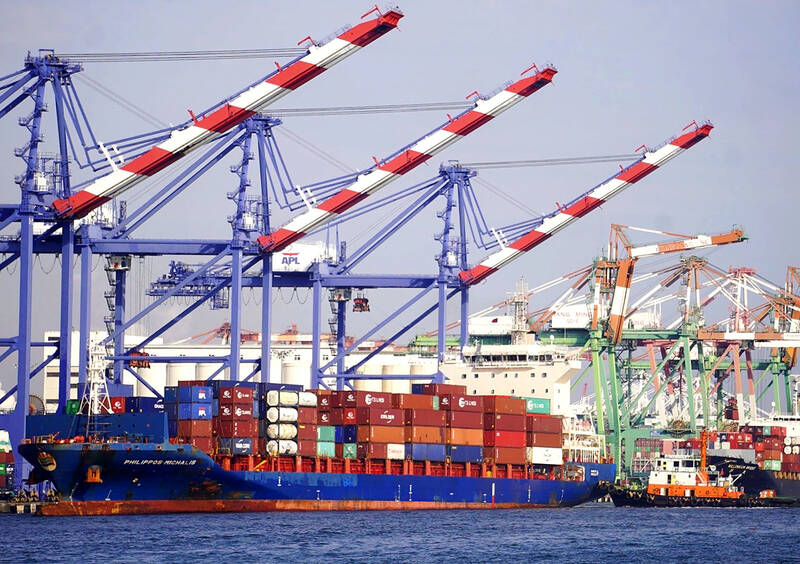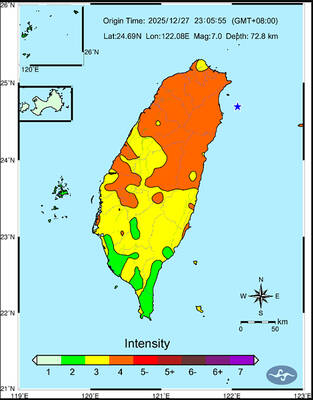Taiwan’s exports set records last year, rising more than 7 percent from a year earlier, although many exporters fell victim to weakening global demand in the second half of the year, the Ministry of Finance announced.
Exports totaled US$479.52 billion, up 7.4 percent from a year earlier, beating the previous record of US$446.37 billion recorded in 2021, data compiled by the ministry showed.
The electronic components industry served as the main driver for last year’s export growth, posting US$200.14 billion in outbound sales, up 16.4 percent from a year earlier and accounting for almost 42 percent of the total, with sales from semiconductor suppliers rising 18.4 percent to US$184.14 billion, the data showed.

Photo: CNA
However, outbound sales in the fourth quarter fell 8.6 percent from a year earlier to US$111.81 billion, with exports last month dropping 12.1 percent year-on-year to US$35.75 billion — the fourth consecutive annual monthly decline — although last month’s fall moderated from a 13.1 percent drop in November, the ministry said on Saturday.
Last month’s exports were slightly lower than an earlier estimate by the ministry, which forecast they would fall between US$35.8 billion and US$37.4 billion, down 8 to 12 percent from a year earlier.
Meanwhile, imports last year totaled US$427.6 billion, up 11.9 percent from a year earlier, with a trade surplus of US$51.92 billion.
The robust showing came even though imports last month fell 11.4 percent from a year earlier to US$30.96 billion, while the trade surplus dropped 16.7 percent year-on-year to US$4.79 billion, the ministry said.
Exporters faced headwinds in the second half of last year, caused by a decline in global demand, which paved the way for inventory adjustments in many industries, but the stronger first half helped Taiwan maintain its uptrend in exports for the full year, the ministry said.
Fast-growing inflation, which prompted aggressive rate hike cycles by major central banks around the world, discouraged consumers from spending, Department of Statistics Director-General Beatrice Tsai (蔡美娜) said.
Russia’s invasion of Ukraine continued to hurt the global economy, while a wave of COVID-19 infections in China also sent global demand into a tailspin, Tsai said.
A relatively high comparison base in December 2021 also affected last month’s exports data, she added.
All major industries last month reported a decline in outbound sales, except the semiconductor sector, which posted US$14.91 billion in exports, up 0.8 percent from a year earlier.
The broader electronic components industry, which includes semiconductor suppliers, saw exports fall 1.4 percent from a year earlier to US$16.04 billion — the second consecutive annual monthly decline, Tsai said.
The electronics industry accounted for 44.87 percent of Taiwan’s total exports last month.
Exports posted by the information and communications industry, and the video and audio industry together fell 10.7 percent year-on-year to US$5.19 billion, while exports reported by the optoelectronics sector fell 30.3 percent to US$732 million, the ministry said.
Old economy industries, in particular, felt the pinch from the global slowdown, with exports posted by the base metal, machinery, and plastics and rubber industries falling 22 percent, 9.4 percent and 33.8 percent respectively, to US$2.43 billion, US$2.24 billion and US$1.68 billion last month, the ministry said.
Exports posted by the chemical, transportation and mineral industries fell 28.4 percent, 11.6 percent and 25.4 percent respectively, to US$1.49 billion, US$1.17 billion and US$893 million, the ministry said.
While China, including Hong Kong, last month remained the largest buyer of Taiwan-made goods, exports to the country fell 16.4 percent from a year earlier to US$14.28 billion due to interruptions caused by the COVID-19 pandemic, the ministry said.
ASEAN countries were second, purchasing US$5.73 billion of Taiwanese goods, down 10.8 percent from a year earlier, while exports to the US, Europe and Japan fell 2.6 percent, 10.5 percent and 6.1 percent respectively, to US$5.67 billion, US$3.16 billion and US$2.59 billion, the ministry added.
For last year as a whole, China was the largest buyer of Taiwanese goods, with purchases totaling US$185.92 billion, down 1.6 percent from a year earlier, the ministry said.
Looking ahead, Tsai said that weakening global demand and fewer working days this month due to the 10-day Lunar New Year holiday mean Taiwan’s exports are expected to post a year-on-year decline of 20 to 24 percent to between US$30.4 billion and US$32 billion.
While many major industries are expected to continue to experience a slowdown, Tsai said that the steel industry could see a revival, as some steelmakers in the region have raised wholesale prices, expecting robust demand.

A magnitude 7.0 earthquake struck off Yilan at 11:05pm yesterday, the Central Weather Administration (CWA) said. The epicenter was located at sea, about 32.3km east of Yilan County Hall, at a depth of 72.8km, CWA data showed There were no immediate reports of damage. The intensity of the quake, which gauges the actual effect of a seismic event, measured 4 in Yilan County area on Taiwan’s seven-tier intensity scale, the data showed. It measured 4 in other parts of eastern, northern and central Taiwan as well as Tainan, and 3 in Kaohsiung and Pingtung County, and 2 in Lienchiang and Penghu counties and 1

FOREIGN INTERFERENCE: Beijing would likely intensify public opinion warfare in next year’s local elections to prevent Lai from getting re-elected, the ‘Yomiuri Shimbun’ said Internal documents from a Chinese artificial intelligence (AI) company indicated that China has been using the technology to intervene in foreign elections, including propaganda targeting Taiwan’s local elections next year and presidential elections in 2028, a Japanese newspaper reported yesterday. The Institute of National Security of Vanderbilt University obtained nearly 400 pages of documents from GoLaxy, a company with ties to the Chinese government, and found evidence that it had apparently deployed sophisticated, AI-driven propaganda campaigns in Hong Kong and Taiwan to shape public opinion, the Yomiuri Shimbun reported. GoLaxy provides insights, situation analysis and public opinion-shaping technology by conducting network surveillance

‘POLITICAL GAME’: DPP lawmakers said the motion would not meet the legislative threshold needed, and accused the KMT and the TPP of trivializing the Constitution The Legislative Yuan yesterday approved a motion to initiate impeachment proceedings against President William Lai (賴清德), saying he had undermined Taiwan’s constitutional order and democracy. The motion was approved 61-50 by lawmakers from the main opposition Chinese Nationalist Party (KMT) and the smaller Taiwan People’s Party (TPP), who together hold a legislative majority. Under the motion, a roll call vote for impeachment would be held on May 19 next year, after various hearings are held and Lai is given the chance to defend himself. The move came after Lai on Monday last week did not promulgate an amendment passed by the legislature that

AFTERMATH: The Taipei City Government said it received 39 minor incident reports including gas leaks, water leaks and outages, and a damaged traffic signal A magnitude 7.0 earthquake struck off Taiwan’s northeastern coast late on Saturday, producing only two major aftershocks as of yesterday noon, the Central Weather Administration (CWA) said. The limited aftershocks contrast with last year’s major earthquake in Hualien County, as Saturday’s earthquake occurred at a greater depth in a subduction zone. Saturday’s earthquake struck at 11:05pm, with its hypocenter about 32.3km east of Yilan County Hall, at a depth of 72.8km. Shaking was felt in 17 administrative regions north of Tainan and in eastern Taiwan, reaching intensity level 4 on Taiwan’s seven-tier seismic scale, the CWA said. In Hualien, the